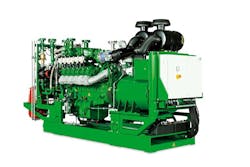Propane-fueled CHP plant kept Puerto Rico Resort powered up even during Hurricane Fiona
Climate change, such as rising sea temperature, is feeding hurricanes to be more destructive. Stats tell the story. Research the meteorological uplift behind Hurricane Ian in Florida, or any named storm in past five years, and you’ll get the picture
And no place has suffered from that ferocity more than Puerto Rico. The island’s grid has been severed numerous times and forced to repair widespread grid damage, including most recently with Hurricane Fiona last month.
The repeated storm damage has inspired many developers both in Puerto Rico and beyond to embrace microgrids and on-site combined heat and power plants as alternatives to the traditional transmission and distribution systems fed by utility power plants.
One such localized unit maintained operations throughout the Fiona storm. The Rincon Beach Resort located in Anasco, PR, stayed working throughout the storm and its aftermath when so many MWs were stranded.
See our Dispatch from T&D World Conference in Charlotte: DER Transformation in Puerto Rico
Think C&I Microgrids are out of reach? Not so fast: Read this Blog from Schneider Electric
The combined heat and power (CHP) plant keeping Rincon Beach Resort going includes a 240-kW electric capacity, propane-fueled unit from 2G Energy. The system was switched to island mode during the Fiona onslaught.
“The 2G propane CHP system allowed us to continue operations through the storm while the majority of facilities struggled to remain online,” Eduardo Somoza, of Rincon Beach Resort, said. “As part of the territory continues without power weeks later, the system has allowed us to continue operating on ‘island mode’.”
2G Energy has supplied CHP systems to several entities in Puerto Rico, including a 2.2-MW gas-fired plant powering a pharmaceutical facility in Manati and a 3.4-MW CHP for a customer in Caguas.
Other 2G Energy CHP plants run on gas or biofuels in California, Connecticut, Maryland, Canada, Mexico and Honduras.
Hurricane Fiona caused more than 20 deaths and $100 million in damages to the island’s agricultural industry, according to reports.
Proponents of cleaning up on-site power generation say propane has lower emissions of greenhouse gases, nitrogen oxide and sulfur oxide than diesel-powered units. The U.S. Propane Education and Research Center noted that this Friday is being celebrated as the first-ever National Propane Day.
“With propane, we’re ensuring affordable, accessible energy while reducing carbon emissions,” said Joe Calhoun, director of off-road business development at PERC. “October 7 is a celebration of propane and its many benefits as a clean and reliable energy source that’s available now.”
-- -- --
(Rod Walton, senior editor for EnergyTech, is a 14-year veteran of covering the energy industry both as a newspaper and trade journalist. He can be reached at [email protected]).
Follow us on Twitter @EnergyTechNews_ and @rodwaltonelp and on LinkedIn
About the Author
Rod Walton, EnergyTech Managing Editor
Managing Editor
For EnergyTech editorial inquiries, please contact Managing Editor Rod Walton at [email protected].
Rod Walton has spent 17 years covering the energy industry as a newspaper and trade journalist. He formerly was energy writer and business editor at the Tulsa World. Later, he spent six years covering the electricity power sector for Pennwell and Clarion Events. He joined Endeavor and EnergyTech in November 2021.
Walton earned his Bachelors degree in journalism from the University of Oklahoma. His career stops include the Moore American, Bartlesville Examiner-Enterprise, Wagoner Tribune and Tulsa World.
EnergyTech is focused on the mission critical and large-scale energy users and their sustainability and resiliency goals. These include the commercial and industrial sectors, as well as the military, universities, data centers and microgrids. The C&I sectors together account for close to 30 percent of greenhouse gas emissions in the U.S.
He was named Managing Editor for Microgrid Knowledge and EnergyTech starting July 1, 2023
Many large-scale energy users such as Fortune 500 companies, and mission-critical users such as military bases, universities, healthcare facilities, public safety and data centers, shifting their energy priorities to reach net-zero carbon goals within the coming decades. These include plans for renewable energy power purchase agreements, but also on-site resiliency projects such as microgrids, combined heat and power, rooftop solar, energy storage, digitalization and building efficiency upgrades.

